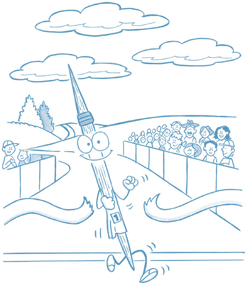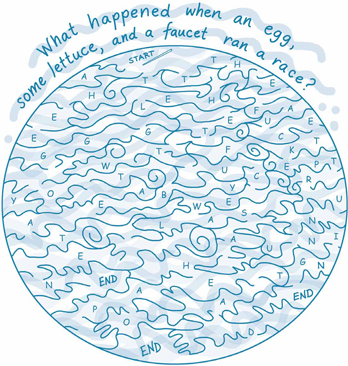Everything Kids' Magical Science Experiments Book (5 page)
Read Everything Kids' Magical Science Experiments Book Online
Authors: Tim Robinson
Tags: #epub, ebook


During the Passover feast, Jewish believers eat only unleavened bread. That means it was not made with any leavening (rising) ingredients, such as yeast. The result is typically a flat, crisp bread.
There are several variations to this experiment that you could also perform. For example, you could use water that is always the same temperature and you could vary the temperature at the place you left the dough to rise. You could place one dough ball on the counter, one in the refrigerator, one in the freezer; one could go outside, and one could go in the oven with the door open and light on (but no heat). In this form of experiment, instead of testing the effects of water temperature on the rising of bread dough, you would be testing the effects of the air temperature.
Another possibility would be to keep both water and air temperatures the same, but vary the amount of salt or the amount of sugar you add to the dough. Since salt and sugar are known to either speed up or slow down the yeast's ability to grow, changing the amount of salt or sugar (but never both in the same experiment) would give you another possible question to explore.
It's always important, however, when doing these types of experiments that you only change one variable at a time. To summarize the possibilities discussed here, you should choose one of the following variables to change, and therefore study:
- Temperature of the water
- Air temperature
- Amount of salt added
- Amount of sugar added
- Can you think of any others?
(courtesy of Lisa Robinson)
Ingredients
- 1½ cups warm water (110°F)
- 1 tablespoon active dry yeast
- 2 tablespoons white sugar
- 2 tablespoons vegetable oil
- 1 teaspoon salt
- 4 cups bread flour
Instructions
- In a bowl, mix together water, yeast, and sugar. Let stand until it becomes creamy. It should take about 10 minutes.
- Add the oil, salt, and 2 cups flour. Mix in the remaining flour ½ cup at a time.
- Dump the dough onto a lightly floured flat surface and knead it until it is smooth and slightly springy. Do this for 5â10 minutes.
- Dump dough into a greased bowl and cover the bowl with a damp cloth. Place the bowl in a warm location and let it sit for one hour. The dough should approximately double in size.
- Remove dough from the bowl and knead it again for two minutes before splitting the dough and placing the halves in two loaf pans that have been coated with oil or butter. Cover the pans with a damp cloth and let the dough rise for one more hour.
- Preheat the oven to 400ºF and bake your bread for 18â20 minutes, or until the edges turn golden brown.
- Remove from oven, slice, and serve.
Yeast is a remarkable ingredient. Many of the baked goods you eat use some form of leavening, whether it is yeast, baking powder, or something else. You might even want to try baking cookies, or a cake, without adding baking powder, to see what happens. Many prepackaged mixes already include these ingredients, so you don't have to worry about it. But if you bake from scratch, be sure to include them if having your work rise is important to you.
Life in a Fun House

W
ho hasn't been forced to do chores by their parents? Some days it seems like all parents care about is doing chores. Why can't they just relax and enjoy themselves for an evening, and let you do the same? Then again, it is nice to eat dinner on clean plates, and have clean clothes, and not to have to step over garbage to get to the front door, so maybe chores aren't the worst way to spend your time. But what if you could make your chores into interesting, even magical, science experiments?

The Basilisk lizard is a creature that can literally walk on water. It uses the water's surface tension to support itself as it runs on two legs across the surface of water. For this talent, it has been nicknamed “The Jesus Lizard.”
There's no guarantee that doing chores will ever be a task you would consider “fun,” but there are probably items lying around your house that, in your capable hands, could produce some interesting activities. See what you can find in your “fun” house. In this chapter, you'll explore racing toothpicks, balancing candles, magic bouncing balls, and metal in cereal.
See if you can find a hiding place where your family keeps toothpicks. If so, then you are ready for a racing game to see just how fast you can make them go in water. But be carefulâ you don't want to make a big mess that you'll have to clean up afterward.
Question: Can you make toothpicks race through water?
- Several toothpicks
- Aluminum pie pan or similar
- Water
- Liquid detergent
- Fill the pan with enough water to float the toothpicks.
- Arrange toothpicks on the surface of the water in the shape of your choice. You might want to try a triangle, a square, or a pentagon. Be sure to lay the ends of each toothpick across the ends of another, so they don't float away.

- Take one additional toothpick and dip one end in the liquid detergent.
- Carefully place the soapy end of the extra toothpick as close as possible to the center of the arranged toothpicks in the pan.
- The toothpicks should shoot out of formation.
This experiment demonstrates the surface tension of water. At the surface of the water, the molecules are held together and this tension is what helps the toothpicks stay close together. Liquid detergent breaks that surface tension, and causes the toothpicks to move away suddenly. It doesn't take much detergent to cause this effect, so it's possible that if you were to try this again using the same water, nothing would happen. You may have to dump the first batch of water and start again.
Would you like to see your toothpicks in a race? Set up the experiment again with a fresh batch of water in the pan. Carefully place a set of “racers” in the pan all pointing toward the far end of the pan. Dip an entire toothpick in liquid detergent and drop it behind the lined-up toothpicks. Be sure to place it perpendicular to the toothpicks that will be racing. Which one moves the farthest? The fastest?
This experiment can also be done using pepper sprinkled across the surface of the water in the pan. Try it and watch the pepper scurry away!

SURFACE TENSION:
A force that keeps water molecules stuck together near the water's surface.
Most schools provide drinking fountains for their students. These machines pump water from the school's water supply up through a series of pipes and out a faucet. To bring the water from under the ground up to where you can drink it takes a lot of effort. But to make water flow the other direction, downward, doesn't take any effort at all, thanks to gravity. In this experiment, you will see how gravity affects water pressure and how you can produce different streams of water from the same container just by adjusting the height of the water.
Question: How does gravity affect water streaming out of a container?
- Empty 2-liter plasticc soda bottle
- Scissors
- Adult helper
- Plenty of water
- Large cake pan or cookie sheet with sides
- Ask your adult helper to use the scissors to cut three small holes in the plastic bottle. One hole should be above the middle of the bottle, one should be near the middle, and one should be about four inches from the bottom. The holes should be about the size of a nail hole.
- While placing your fingers over the holes, fill the bottle with tap water.
- Place the bottle inside the cake pan so that water can stream out without spilling on the counter.
- At the same time, remove all three fingers covering the holes and watch how the water streams out.
At first it seems that the water should be streaming out the same no matter where the holes are. However, water has weight. The more water there is pressing down at the spot where the holes are, the more water pressure there is, and the faster it comes out. This is why the water coming out of the top hole doesn't flow out very fast or far. The middle hole produces a stream that moves faster than the top one, and the bottom hole has water squirting out of it very quickly.
You may have read in other science experiment books about an activity where you produced layers of liquids, such as oil, water, and corn syrup. You can try that here with the added twist of watching the liquids pour out of the holes. To do this, you will Life in a Fun House need to keep the holes covered with pieces of tape until you are ready to release the liquids. Pour enough corn syrup or pancake syrup to fill the bottle to a point above the first hole. Then pour in enough water to fill the bottle to a point above the second hole. Finally, pour in enough cooking oil to fill the bottle to a point above the third hole. Now return the bottle to the cake pan. Quickly and carefully remove the three hole covers and watch to see how these three liquids pour out. What happened?




